Walking through San Juan’s bustling Mercado de Santurce, the scent of Puerto Rican cuisine wraps around you like a warm hug. Your journey in Puerto Rico begins with a bite of mofongo, mashed plantains with garlic and crisp chicharrones. It shows you how food tells stories of resilience and fusion.
This island’s food isn’t just a meal; it’s a bridge between Taíno roots, Spanish influences, and African traditions. Every dish, from the smoky lechón asado to the tang of fresh marién guava, offers a taste of Caribbean history.
Puerto Rico’s island gastronomy invites you to savor contrasts. Imagine crisp ocean breezes meeting the smoky kiss of a charcoal grill. Or the dance of sweet plantains with savory sofrito.
A Puerto Rico food tour isn’t just about eating, it’s tracing the pulse of a culture. It turns everyday ingredients into celebrations. From street carts serving alcapurrias to family-owned casa de comidas, every bite deepens the connection to this land’s soul.
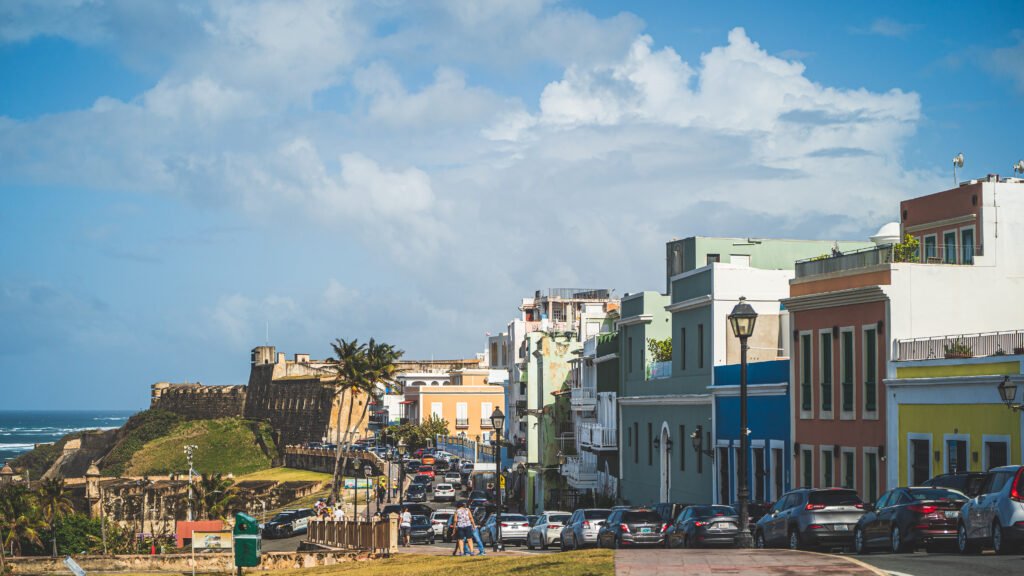
Key Takeaways
- Authentic Caribbean food in Puerto Rico blends Indigenous, Spanish, and African flavors into every dish.
- Iconic dishes like mofongo and lechón asado highlight centuries of cultural exchange and island traditions.
- Culinary travel here reveals how geography and history shape ingredients like plantains, annatto, and fresh seafood.
- Puerto Rican cuisine uses bold spices and fresh tropical fruits to create vibrant, layered flavors.
- Exploring island gastronomy connects travelers to local stories and community rituals passed through generations.
The Rich Heritage of Puerto Rico Cuisine
In Old San Juan’s markets, the smell of garlic and olive oil fills the air. The colors of ajíes dulces add to the story. Puerto Rican food history is a mix of three continents, each leaving its mark.
Taíno, Spanish, and African Influences
Local historians talk about Taíno ingredients like yuca and guanabana in today’s dishes. Spanish colonization brought olives and citrus. African traditions introduced plantains and slow-cooked stews.
This mix created a unique cuisine. It’s both familiar and special in its own way.
The Evolution of Puerto Rico Cooking Techniques
Traditional cooking methods are still used today. Clay pots simmer stews over fires, while chefs smoke-roast meats. The sofrito base, with culantro, garlic, and peppers, ties every dish together.
“Sofrito is our compass,” a chef said. It guides flavor back to its roots.
Key Ingredients in Traditional Puerto Rican Dishes
| Ingredient | Origin | Role |
|---|---|---|
| Culantro | Indigenous Caribbean | Essential in sofrito base for depth |
| Ajíes Dulces | Native to the islands | Adds subtle heat to stews and soups |
| Plantains | African and Spanish trade routes | Star of sides like mofongo and tostones |
Mofongo: The Iconic Puerto Rican Delicacy
Your first bite of mofongo recipe becomes amazing. It seems like a mix of soft plantains, roasted garlic, and chicharrones. This traditional mofongo is a big deal in plantain dishes. It shows the strength and creativity of Puerto Rico.
Every Puerto Rican street food stall and home kitchen makes mofongo with love. They use green plantains and a pilón to make it. This method has been passed down for years.
“Mofongo is our love letter to Africa and the Caribbean,” says Chef Ana Rivera of San Juan’s El Fogón, her hands shape a garlic mofongo variation right before your eyes. “It’s comfort food with a backbone.”
The mofongo recipe is all about textures. Fried plantains become soft and buttery. Then, they mix it with olive oil and garlic until it’s silky.
Chicharrones add a savory touch. But chefs like Rivera like to try new things. They stuff it with shrimp or mushrooms for a twist. Garlic mofongo variations are popular in Puerto Rican street food carts. They add sofrito or stewed meats on top.
Mofongo brings people together. You can find it at markets or family gatherings. Street vendors in Ponce offer it as a quick meal. San Juan’s chefs add truffle oil for a fancy touch.
If you love bold flavors, mofongo is a must-try. It’s a taste of Puerto Rico’s heart. Next time you’re looking for something new, try it with similar Latin American street food traditions. But always come back to the original.
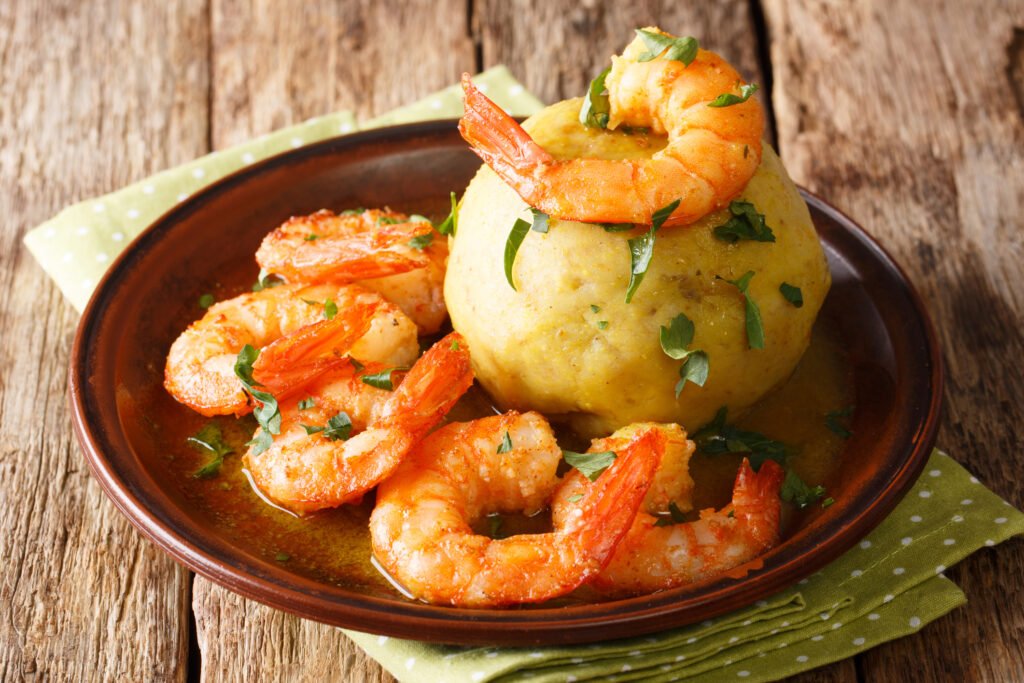
Savoring Lechón Asado: Famous Roast Pork of Puerto Rico
When you smell crispy skin pork in the air, you’re in Puerto Rico. Lechón is more than food; it’s a journey from mountains to coast. The whole roast pork tradition is in every charred piece and smoky smell. It’s a story told through fire and smoke.

The Art of Preparing Traditional Lechón
Patience is key. Pit masters rub garlic, oregano, and salt into the pig’s skin. Then, they skewer it and roast it for hours over oak embers. The goal is a crispy skin pork that shatters and reveals tender meat.
You’ll see cooks test the roast by tapping the skin. When it rings, it’s ready.
Regional Variiations Across the Island
Every region has its own twist on Puerto Rican barbecue:
- West of Ponce, lechón gets an orange color from annatto.
- In Cayey, garlic is layered thick on the meat.
- Near the Ruta del Lechón, mesquite smoke adds a deep flavor.
Celebrating at the Lechoneras of Guavate
Weekends at the Ruta del Lechón are a feast of laughter and skin. At Guavate, families enjoy Puerto Rican lechón under palm roofs. Servers give you mojo sauce in tiny glasses.
The sizzle of meat and salsa rhythms fill the air. It’s a celebration of tradition and hunger. Pit masters like Don Carlos of La Cueva de Oro carve meat with skill. Every slice shows juicy layers under the crispy skin.
Essential Puerto Rican Culinary Travel Experiences
Exploring Puerto Rico’s flavors is more than just eating. Puerto Rico food tourism lets you dive into the stories behind each spice and cooking method. Your travel will show you that the best meals start at the source.
Like visiting local food markets at dawn. There, fishermen bring in their catch, and you find plantain leaves and smoked paprika.
Food Festivals Worth Planning Your Trip Around
At Saborea Puerto Rico, chefs turn food into art. Cayey’s Pork Festival celebrates lechón with street parties. A vendor tells you, “
Every crackle of the grill tells a story our ancestors cooked into this meat.
” These festivals are like living history lessons.
Guided Food Tours in San Juan
- San Juan culinary tours show you Old San Juan’s charm. They mix tradition with modern twists in the SoFo gastronomy district.
- La Factoría Market is a must-visit. There, alcapurrias are made with skill passed down through generations.
Hidden Gems Beyond Tourist Areas
In rural towns, you find authentic food experiences. In Jayuya, a family teaches you to make tostones. Near Ponce, local food markets sell sun-dried mangoes and coffee.
These places let you see Puerto Rico’s true spirit.
Beloved Street Foods of Puerto Rico: Fritters, Alcapurrias, and Bacalaítos
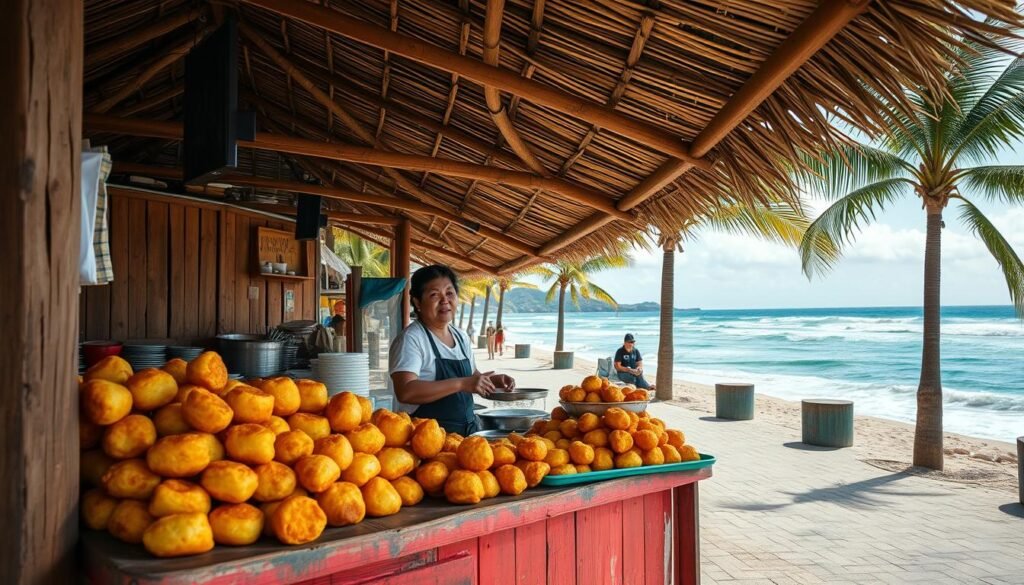
Walking along Piñones’ coastal paths, the smell of Puerto Rican fritters draws you in. At the Piñones food kiosks, vendors expertly make alcapurrias. They use grated yautía and banana dough to hold spiced beef or crab inside. The first bite is like opening a golden shell, releasing steam into the salty air.
These treats are more than snacks. They tell stories of resilience and creativity.
In Santurce’s mercado, pastelillos de carne come out at dawn. Their flaky crusts hold tender seasoned meat. Nearby, bacalaítos shine in oil, filled with cod and onion. Each bite of these Puerto Rican fritters is like shaking hands with history.
- Alcapurrias stuffed with picadillo or crab
- Golden bacalaítos with a delicate crunch
- Pastelillos de carne turnovers dripping with juices
Guided tours with Epicurean-escape show hidden kiosks. Vendors like Doña Rosa share recipes from their families. “
These fritters are our movable feasts,” she says, flipping a batch of bacalaítos. “They turn any street corner into a feast.”
From Piñones to Old San Juan, these bites connect you to the island’s heart. Enjoy them at food carts where smoke and laughter mix. There, you’ll feel Puerto Rico’s pulse.
Puerto Rico Beverages: From Piña Coladas to Coquito
Your journey through Puerto Rico takes you to where sugar cane fields meet the coast. Every sip here tells a story. The island’s drinks are as rich as its history, from aged rum in the mountains to chilled coconuts on the beach.
Rum Traditions and Distillery Tours
Every handcrafted cocktail has a story behind it. At Bacardí’s Casa, you learn about Puerto Rican rum tours. Here, master blenders show how oak barrels shape each spirit. Smaller Barrilito stills make rum by hand, keeping centuries-old techniques alive.
Tropical Fruit Drinks
- Coco frío: chilled coconut water with a straw, cracked open on the spot
- Parcha batidos: tangy passion fruit blended with ice
- Mavi: a deep purple drink made from tree bark, a pre-Columbian treat

Coffee Culture in the Mountains
| Plantation | Region | Signature Brew |
|---|---|---|
| Finca La Troje | Utuado | Medium roast with hints of caramel |
| Hacienda La Esperanza | Yauco | Single-origin beans, volcanic soil grown |
At Christmas, the traditional coquito recipe is a family tradition. Each household has its own secret recipe, passed down through generations. These drinks are more than just refreshments; they connect you to the island’s heart.
Desserts That Define Puerto Rico Sweet Traditions
In Old San Juan, the smell of caramelized sugar and tropical fruit filled the air. Your first taste of coconut tembleque recipe at a family-owned luncheria becomes unforgettable. It’s a gelatinous coconut pudding that shakes with every spoonful. The island’s Caribbean sweet treats mix Spanish techniques with Caribbean abundance.
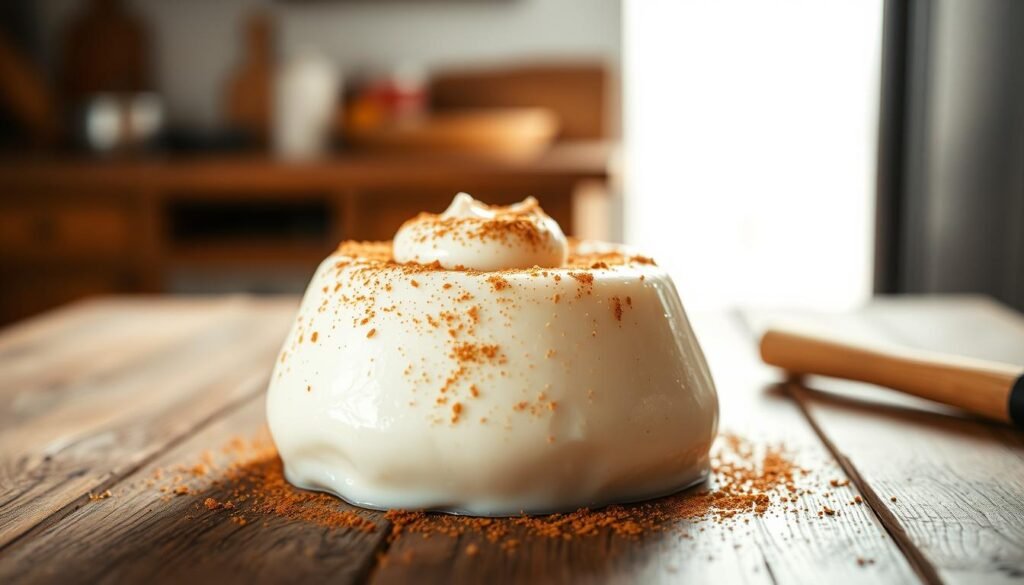
Coconut-Based Treats
Tembleque’s mix of coconut milk and cinnamon shows patience is key. Elders stir it until it turns into liquid gold. Guava pastries and maizenda desserts like majarete, a corn-based pudding, highlight the island’s agricultural heart. These Caribbean sweet treats are like a warm hug from the past.
Traditional Flan Variations
- Cheese flan: A creamy custard with a molasses glaze, contrasting sweet and salty notes
- Pumpkin flan: A fall-inspired twist using island-grown calabaza squash
- Flancocho: A layered flan and cake batter creation popular at family reunions
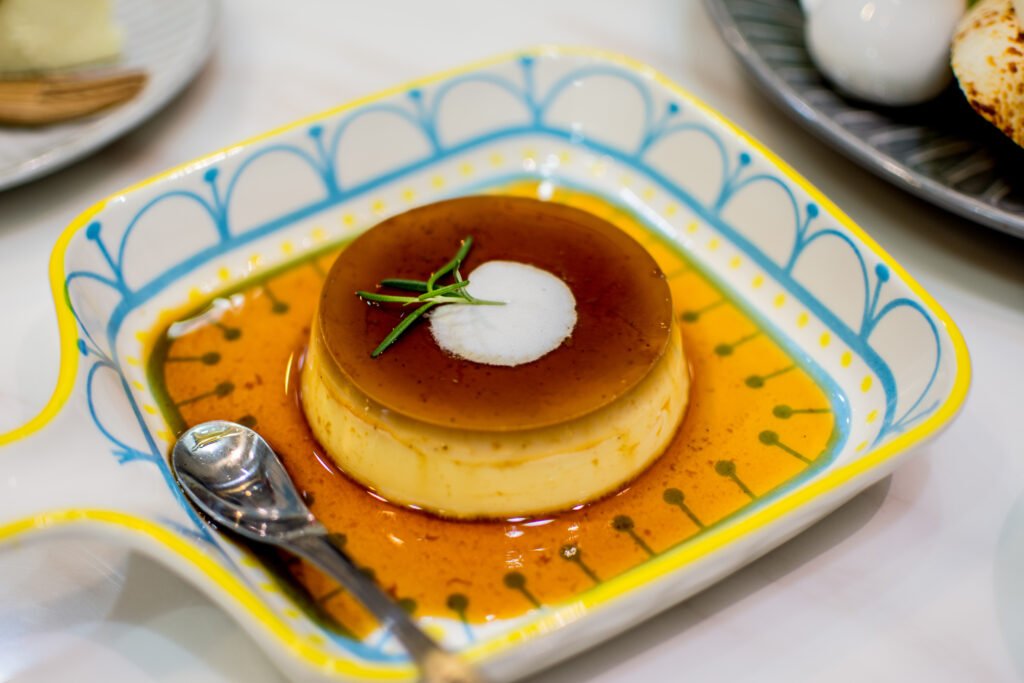
Tropical Fruit Desserts
| Dessert | Flavor Profile | Cultural Moment |
|---|---|---|
| Guava pastries | Jam-like guava filling in crisp pastry | Served with coffee at morning meriendas |
| Arroz con dulce | Cinnamon-spiced rice pudding with coconut milk | Christmas Eve tradition in Ponce |
| Plátanos en tentación | Caramelized plantains with cinnamon sugar | Weekend dessert in coastal towns |
These desserts are more than recipes, they’re family treasures passed down through generations. At every bite, you taste the Caribbean sweet treats that make meals special. They show that sweetness here is both art and family memory.
How to Recreate Puerto Rico Flavors at Home
After your trip, you’ll crave to bring the island’s flavors into your kitchen. Start with homemade sofrito, the heart of Puerto Rican recipes. Mix fresh culantro, sweet peppers, garlic, and olive oil into a paste. This paste should smell like San Juan’s markets.
If you can’t find culantro, use cilantro instead. But add lime zest to keep the flavor bright.
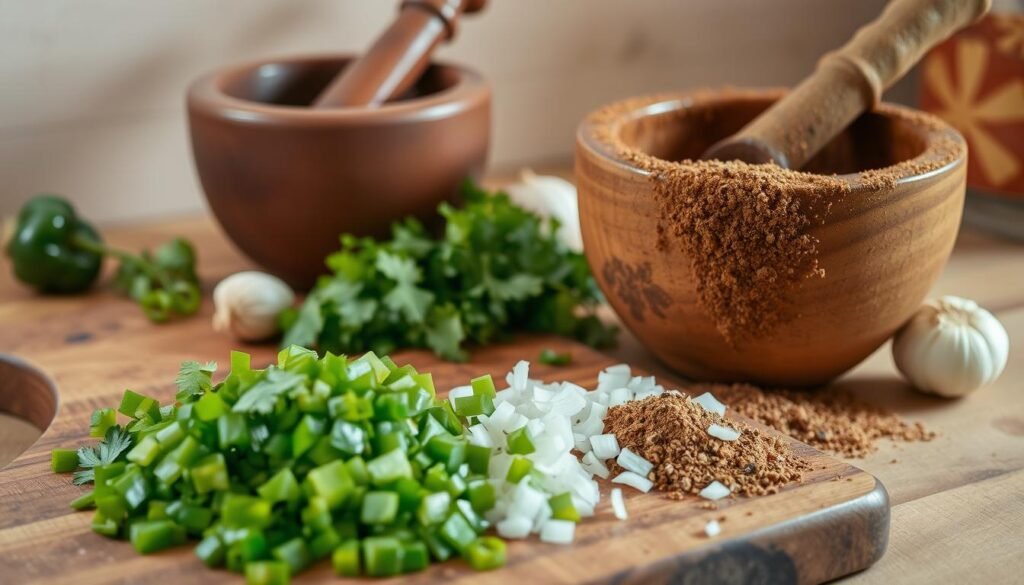
Learn Caribbean cooking techniques like toasting rice in adobo seasoning for authentic arroz con gandules. The adobo seasoning mix—garlic, oregano, and annatto—needs time to blend. Make a batch and store it in clean jars.
The Puerto Rican abuela’s secret: Use a mortar and pestle for spice pastes. Machines can crush too harshly.
| Ingredient | Authentic Source | Alternative |
|---|---|---|
| Recaíto (sofrito) | Latin markets | Pre-made frozen blends |
| Guanciale | Butcher shops | Prosciutto |
| Annatto seeds | Online spice retailers | Paprika + turmeric (for color) |
Slow-cooking is essential. Simmer stews like gandules (pigeon peas) for hours. This way, the pork shoulder will fall apart easily.
For quicker meals, try quick-frying tostones with garlic-lime mayo.
“The best arroz con gandules balances smoky, sweet, and tangy notes—never rushed,”
says Chef Lourdes Pérez of San Juan’s La Factoría.
Adobo seasoning is more than a rub; it’s a way of cooking. Take your time to layer flavors. Your kitchen will then buzz with the island’s spirit. These methods can turn any kitchen into a gateway to Puerto Rico’s heart.
Conclusion: Embracing Puerto Rico Through Its Culinary Heritage
Exploring Puerto Rican food culture is like diving into the island’s heart. Every mofongo bite or coquito sip tells a story of resilience. It mixes Taíno, African, and Spanish traditions.
This heritage is more than just food. It shows you how Puerto Rico has survived and thrived. It connects the island’s past and present.
Sustainable food tourism lets travelers celebrate this rich history. By choosing local foods and guided tours, you can support the community. This way, you got to know the island’s true flavors.
From San Juan’s lively plazas to mountain coffee farms, you connect with Puerto Rico. These experiences show you the island’s true spirit.
Trying Puerto Rico’s food is like experiencing its soul. Markets in Ponce, lechón asado in Guavate, and family-made pasteles are all part of it. These moments remind you of the importance of preserving these stories.
For those looking for more than a vacation, Puerto Rico’s kitchens and streets offer deep connections. Choosing family-run restaurants or exploring new places shows respect. These acts help keep the island’s culinary soul alive for everyone.


